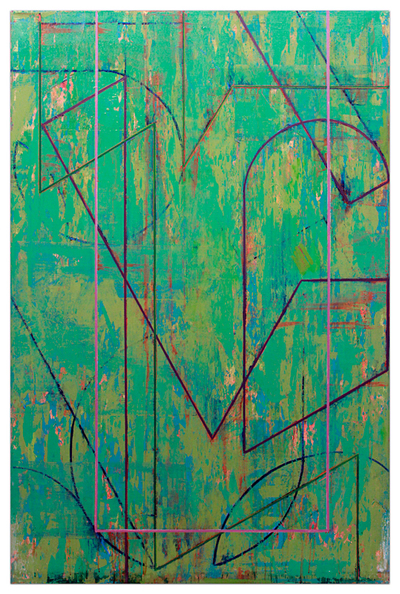A Precise Coda…
Scott Hadfield: New Paintings
April 27th- June 1st
Barbara Krakow Gallery
Boston, MA

Scott Hadfield, Installation View, Courtesy Barbara Krakow Gallery
There is an unnerving level of grace present in this focused sampling (just six paintings) of recent work by Scott Hadfield at the Barbara Krakow Gallery in Boston. The feeling is almost unsettling. Hadfield’s quiet, meditative exploration of nearly identical forms, and the ruggedness of the painted and scraped terrain that accompany them yield profoundly precise constructions.
That precision, however, is something of a ploy. Hadfield, who greatly admires Jasper Johns, subtly shifts the armature of shaped lines that these works share, creating the illusion of movement passing through time. The lines here are stock-still, yet the painted surfaces around them abound with gestures and edited passes across the canvas. The marks are both foundational and animating. They ground the work while at the same time pushing the lines out of the rough-hewn space they occupy.
While working on these paintings Hadfield noticed something familiar about the formatting of the work. If you turn the paintings once in a counter clock-wise direction you immediately see the outline of the American flag. This accidental homage to Johns finds its way into the titles that refer to work that Johns made in 1954-1955. Thus 5455 begins the sequencing for Hadfield’s titles, with the numbers being followed by the initials of artists he admires. Still, in a sense, the titles are afterthoughts, and despite their apparent kinship with the work they are uncalculated and somewhat disembodied without being a distraction, exactly.

Scott Hadfield, 5455JM, 2011, Oil on canvas
5455JM motors to life with Hadfield’s distinct mark making. The lines are concisely placed, and the paint here feels more removed than applied. The twists and turns of the signature motif seem to almost float above the canvas’s surface. This distinct characteristic gradually dissipates as Hadfield moves into the other paintings and the unanchored bars or intervals he uses to organize the work sink deeper into the paint itself. “Sink” might be the wrong word to use because it implies a natural process, a lowering based on some natural law. Better, perhaps, to say that the lines adhere along some painted magnetic charge.
Hadfield’s earlier work, inspired by the squat granite (earthbound, as he calls them) country churches in Yorkshire, informs some of the architecture of the newer work as well. These elements from the past (both literally and figuratively) are furrowed deeply into the present tense, the “now” of the work. As the exhibition essay accompanying the show so astutely puts it: “Scott Hadfield’s painting practice takes an altered approach to archeology. Where a researcher uncovers what has come before and digs deeper and wider to gain a clearer picture, Hadfield pushes, pulls and scrapes not only to reveal what has come before but also to build towards the future. He alters each additional layer to unify the surface, yet each action of selective removal keeps some awareness of the individual layers. By doing this, he promotes the importance of chance conversations and continuity.”

Scott Hadfield, 5455FS, 2012, Oil on canvas.
The idea of archeology here is apt in the sense that Hadfield sweeps across the surface of these paintings with a compelling desire to move across time, infiltrating the moment with everything that’s come before. Nothing that’s happened in the past can destabilize what happens next, it only exists to inform the narrative of progress that the weight of time imbues it with.
An example of this is 5455FS. A striking deeply worked and richly colored piece where Hadfield activates the entire surface of the canvas. Sized at 60 ¼ x 40 ½ (as is all the work) the painting is a controlled caching of intent and ambition. Bearing the rough coordinates of the rest of the work, 5455FS bursts out with the vigor of discovery. Layered lines weave in and out and paint drips sideways while a series of expressive brushstrokes animate the structural components around them.

Installation view with 5455RR, 2012.
What Hadfield does is as important as what he doesn’t do. The editing is a precise coda to the content and what’s rendered is a remarkable balance struck. These six paintings are in a dialogue where the mundane nature of craft is exploited to suit the higher, more meditative, callings of exploration and discovery.
Robert Moeller is the website coordinator of Art New England
